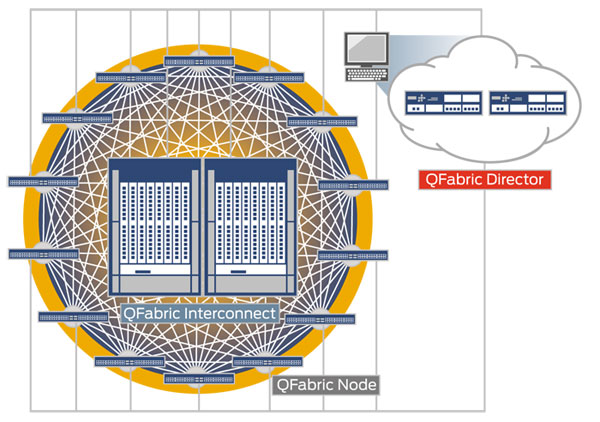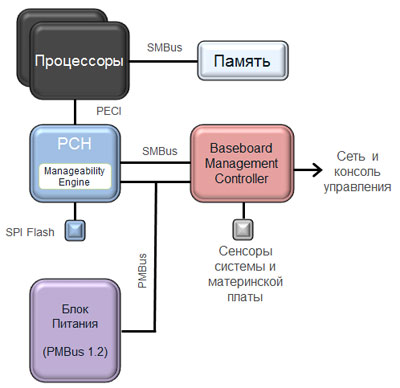Data Centers: Intel's Point of View

May 30-31, Moscow hosted the “Data Center World - 2012” forum, in which the delegation of Intel took part. Let's use this occasion to briefly, in an overview form, outline the vision of today's Intel and the near-term data center. The article is intended primarily for those habra people who have a desire for a short time to get an idea of the topic - we invite experts to go to the comments and express their point of view, where and why Data Centers are going.
Faster
The article on ten-gigabit already mentioned that high-speed Ethernet technologies, ranging from 10G to 100G inclusive, turned out to be the most in demand in the data center, and 40G, one can say, was just there. This, of course, is not surprising - such a density and multidirectional traffic can be found in few places. The isolation of the needs of the data center caused a selection of a whole class of specialized network devices, primarily switches, which went from a standard box to distributed cluster solutions, an example of which is the recently introduced Juniper QFabric complex.
QFabric switching complex topology
Well, if you don’t take a cosmic scale and consider a small or medium data center - will it benefit from increasing the speed of internal lines, will the investments pay off? Practice shows that yes, win. Replacing the “beard” of Gigabit lines by 10G will increase the capacity of a single server, reduce the number of ports and cables needed - in general, the efficiency of data processing will increase by about 50%. Additional profit can be obtained from the transfer of SAN lines (for example, Fiber Channel) to 10G transport.
')
Modern
Despite the pessimistic statements of Mr. Moore, the law of his name is currently still in effect, which means that every year brings a significant increase in processor performance. For example, over the past 4 years, the integer performance of Intel Xeon processors has increased three times - that is, a simple update of the server fleet will allow increasing the data center capacity without any mental labor. That is why the owners of large Data Centers are lining up for each new server update - on a large scale the difference becomes especially noticeable. However, the increase will also have a beneficial effect on all other data centers - at least due to the possibility of reducing the number of units.Another breakthrough line is the transition of servers and storage systems from hard drives to SSDs. Here, the performance increase is such that even Moore did not dream. It is estimated that an array of 7 SSDs has the same read / write performance as an array of 75 SAS 15k HDD. Obviously, with an equal volume, the cost of SSD will be significantly higher, but in the case when speed plays a decisive role — for example, in OLTP mode — the advantage of SSD will be obvious. It is necessary to take into account other progressive features of SSD: low power consumption and heat, small size - all this is also important for the data center.
Warmer
Intel's thermophilic innovations have already been discussed in a separate article . I will not resist the temptation to show again the video from it - it hurts too picturesquely.Briefly, the initiative can be stated as follows: stop cooling the data center! They are not built for people who are comfortable working at 20 degrees, but for equipment that should be able to operate at a temperature that is favorable for us. Increasing the temperature by 1 degree reduces the consumption of data center cooling by 4%: the effect of warming to not extreme 30 degrees can be easily calculated in the mind.
A sufficient number of experiments have been carried out, showing that Data Centers, including those that are extremely large, work quietly at 30-35 degrees, without air conditioning and humidity control, provided the equipment is well ventilated and the equipment is adapted to similar conditions (called in Intel HTA - High Ambient). Temperature) - while savings in the millions of dollars a year. How this adaptation is made is shown in the example below.

HTA in action: on the left - the traditional placement of elements on the server's motherboard, on the right - optimized for better blowing processors
It is also necessary to prepare premises for data centers by applying active means of monitoring and controlling heat flows in it. One of these tools is Intel Data Center Manager (DCM) - a set of libraries and development tools that are integrated into the data center management system and provide it with information on heat generation and power consumption of Data Center components.
More economical
Optimizing work is necessary not only for the entire data center as a whole, but also for each of its components separately. In the data center ecosystem of Intel, this work is done by Intel Node Manager, a technology embedded in Intel server platforms. His responsibilities include fine-tuning the servers of Data Centers in order to optimize their energy consumption. The tuning is actually subtle, at the level of the element base, mainly processors and memory (turning off the cores, reducing the frequency).Being built into the core of the server platform, the Node Manager receives all server performance indicators firsthand and in real time, which allows you to accurately measure all the resources it needs.

Intel Node Manager Architecture
For example, uninterrupted power racks are always counted with a margin - and rightly so. However, when the rack is completed and reached the cruising amount of consumption - is this supply too large, maybe it will be enough for another server? The data center should be economical! Another important application of Node Manager is server resource management when it overheats. Again, due to its incorporation into the Node Manager platform, it allows not only to send an alarm to an administrator or stupidly turn off the server, but also to reduce performance with the goal of cooling.
In conclusion, a short talk about the data center, I would like to draw your attention to the title picture of the message. Let's not forget that energy efficiency not only saves significant amounts, but also to some degree affects the environment. But everyone wants to live, so the "green" data center - this is our common choice. May he be conscious and uncompromising!
Source: https://habr.com/ru/post/145504/
All Articles